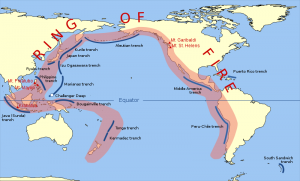
Japan, Indonesia, Mexico, and the Philippines are just a few among countries along the Pacific that have notably frequent earthquakes and volcanic eruptions. These natural occurrences gave rise to what is known today as the Pacific Ring of Fire, so called because of its distinct horseshoe shape of nearly continuous series of volcanic belts and trenches beneath the ocean floor.
More than a half of the world’s active volcanoes are found just along the circum-Pacific seismic belt. It is not surprising that 90% of earthquakes, including the worst and the most devastating ones ever recorded occur within or along these areas.
Plate tectonics has been the long standing and widely accepted theory that explains why such things occur in the Pacific belt. Geologists have observed that certain continents are constantly moving further or closer to each other at a certain rate. It is believed that our earth’s crust is divided in no less than 15 tectonic plates floating on a fluid-like layer just between the crust and the mantle.
The Pacific Plate spans as far and wide as the Pacific Ocean. Small to medium sized plates engulf this gigantic plate – the eastern plates pushing against it and the western plates drifting away from it. The 8.9 magnitude earthquake in Japan was a result of the Pacific Plate subducting to the Japanese Plate.
The Pacific Ring of Fire’s distinct shape is due to the plates colliding and sliding against it. This accounts for the large number of active volcanoes and subduction faults around this area. Perhaps the most remarkable fault along the Pacific Ring of Fire on the West is the San Andreas fault zone which has caused small tremors and multiple quakes due to the constant movement of the fault.
Violent earthquakes usually occur after a noticeable decline or absence of movement along the fault, a harbinger of an impending catastrophe. Earthquake may also come from another source – volcanic eruptions. Immediate effects are felt within 5-10 mile radius, and in some cases, even triggering a tsunami in coastal areas.
Awareness of the situation is the first step to avoid getting in the way of disaster. Japan is one of the best examples of earthquake awareness and preparation. Had it not for their knowledge and application of earthquake technology and their constant routine simulation exercises, more lives and properties would have lost to the 8.9 killer quake.
Related Article:






